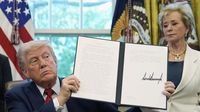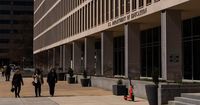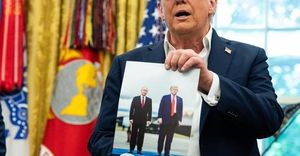On July 24, 2025, President Donald Trump signed an executive order setting the stage for one of the most sweeping and controversial crackdowns on the nation’s unhoused and disabled population in recent memory. The order, which called for the involuntary commitment of unhoused people to institutions in a purported bid to “restore public order,” has triggered a fierce debate among disability rights advocates, educators, and civil liberties groups, while drawing unsettling parallels to some of America’s darkest legislative chapters.
The effects of this policy were felt almost immediately in Washington, DC, a city with an estimated 5,000 people living without permanent shelter, including roughly 800 who sleep on the streets. Beginning August 14, the nation’s capital saw its largest homeless encampment destroyed, leaving many scrambling for a place to go and losing what little they owned. According to Mother Jones, the scale and speed of this sweep sent shockwaves through advocacy circles and local communities alike, with many questioning both the legality and the humanity of such measures.
Disability rights organizations have been quick to condemn the executive order, arguing that it not only violates civil liberties but also seeks to unravel decades of legal precedents and consent decrees designed to protect the rights of unhoused and disabled individuals. As reported by Mother Jones, the administration’s move is widely seen as a draconian step that targets some of society’s most vulnerable, under the guise of public order.
Dr. Sam Tsemberis, the architect of the widely praised Housing First approach—an evidence-based model that prioritizes providing housing to end homelessness—spoke candidly about the administration’s strategy. “People will get discharged from the hospital. They will get released from the jail. And they’ll be back out on the street and the thing will be going in a circle again,” Tsemberis told Reveal. “The only way to end homelessness is to provide housing.” His words echo the frustration of many experts who see the new policy as a step backward, replacing proven solutions with punitive measures.
The Trump administration’s actions in the realm of education have drawn similar criticism. On August 21, 2025, it was revealed that the administration had quietly rescinded 2015 federal guidance that protected the civil rights of approximately five million children in public schools who are not proficient in English. This guidance, issued by the Justice and Education departments, had laid out the legal obligations of schools to prevent discrimination and ensure compliance with federal civil rights laws for English learners. The now-rescinded document is available only for historical reference on the Education Department’s website, marked with a red disclaimer.
President Trump’s stance on education has been consistent with his broader push to minimize federal oversight. “As you know, we want to bring education back to the states, take the federal government out of it,” he said in July. “A little tiny bit of supervision, but very little, almost nothing. Like to make sure they speak English. That’s about all we need.” According to The Washington Post, this philosophy has manifested in the elimination of multilingual services across federal agencies, including the Education Department, and a renewed emphasis on English as the nation’s “official language.”
Attorney General Pam Bondi reinforced this direction in a July memo, instructing all federal agencies to minimize non-essential multilingual services and redirect resources toward English proficiency and assimilation programs. “Consistent with that direction, the Justice Department will lead a coordinated effort to minimize non-essential multilingual services, redirect resources toward English-language education and assimilation, and ensure compliance with legal obligations through targeted measures where necessary,” Bondi wrote. The memo further stated that institutions receiving federal funding would no longer be required to comply with the previous prohibition against national origin discrimination affecting limited English proficient persons.
The impact of these changes has been swift and far-reaching. In March, the Education Department, under Secretary Linda McMahon, fired nearly all staff in the office dedicated to supporting English learner students. The department stated the 2015 guidance was rescinded “because it is not aligned with administration priorities,” according to Education Week. Earlier in the year, the Justice Department also ended long-standing monitoring agreements with school districts in Boston, Newark, and Worcester regarding their handling of English learner education.
These moves have not gone unnoticed by advocates and former officials. Montserrat Garibay, who led the Education Department’s Office of English Language Acquisition during the Biden administration, warned in an interview with Chalkbeat that “there’s a high risk that [English learner] students are not going to be receiving their linguistic and their academic support that they need.” Washington Representative Pramila Jayapal was even more direct, telling The Washington Post, “Yet another ridiculous step from Trump that will only hurt kids working to learn English. This discriminatory move will impact millions of children, many of whom were born in this country.”
For many historians and disability advocates, the recent executive order and rollback of civil rights protections evoke the specter of the so-called “Ugly Laws” of the 19th and early 20th centuries. As detailed in Mother Jones, these laws—first enacted in San Francisco in 1867—criminalized poverty and disability, making it illegal for people deemed “unsightly” due to disease, injury, or disability to appear in public. The rationale, as University of California, Berkeley professor emeritus Susan Schweik explained, was to remove “undeserving” poor and disabled people from public view, often institutionalizing them in harsh, underfunded facilities.
Schweik, author of The Ugly Laws: Disability in Public, notes that these ordinances were rarely enforced to the letter but still had devastating effects, reinforcing social stigma and justifying exclusion. “Disability has always functioned as a rationale, an alibi, an excuse, and a bottom line for all kinds of oppression,” she said. The echoes of that era are unmistakable in today’s political climate, where the language of “public order” and “assimilation” is once again used to justify policies that disproportionately affect poor, immigrant, and disabled communities.
Advocates warn that the administration’s recent moves risk reversing hard-won progress in civil rights and disability inclusion. The disability movement of the 1970s, ’80s, and ’90s played a pivotal role in dismantling the Ugly Laws and securing the passage of the Americans with Disabilities Act. Yet, as Schweik and others point out, the legal remnants and social attitudes that enabled such laws still linger in city codes and policy debates across the country.
As the nation grapples with these sweeping changes, the debate is far from over. Critics argue that the administration’s approach not only fails to address the root causes of homelessness and educational inequity but also threatens to roll back decades of progress toward a more just and inclusive society. The question now is whether the lessons of history will be heeded—or repeated.





